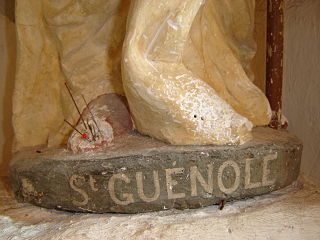 W
WIn Irish mythology, Aengus or Óengus, also called Mac and Óic, is one of the Tuatha Dé Danann and probably originally a god associated with youth, love, summer and poetic inspiration. The son of The Dagda and Boann, Aengus is also known as Macan Óc, and corresponds to the Welsh mythical figure Mabon and the Celtic god Maponos. He plays a central role in five myths reported by medieval Irish texts.
 W
WIn Greek mythology, Anteros was the god of requited love and also the punisher of those who scorn love and the advances of others, or the avenger of unrequited love. He is one of the Erotes.
 W
WAntinous or Antinoös was a Greek youth from Bithynia and a favourite beloved of the Roman emperor Hadrian. After his premature death before his twentieth birthday, Antinous was deified on Hadrian's orders, being worshipped in both the Greek East and Latin West, sometimes as a god (theos) and sometimes merely as a hero.
 W
WBes, together with his feminine counterpart Beset, is an ancient Egyptian deity worshipped as a protector of households and, in particular, of mothers, children, and childbirth. Bes later came to be regarded as the defender of everything good and the enemy of all that is bad. Bes may have been a Middle Kingdom import from Nubia or Somalia, and his cult did not become widespread until the beginning of the New Kingdom.
 W
WChaquén was the god of sports and fertility in the religion of the Muisca. The Muisca and their confederation were one of the four advanced civilizations of the Americas and as they were warriors, sports was very important to train the fighters for wars, mainly fought between the zipazgo and the zacazgo but also against other indigenous peoples as the Panches, Muzos and others. When the Spanish arrived in the highlands of central Colombia, the Altiplano Cundiboyacense, they encountered resistance of the guecha warriors, trained by Chaquén.
 W
WIn classical mythology, Cupid is the god of desire, erotic love, attraction and affection. He is often portrayed as the son of the love goddess Venus and the god of war Mars. He is also known in Latin as Amor ("Love"). His Greek counterpart is Eros. Although Eros is generally portrayed as a slender winged youth in Classical Greek art, during the Hellenistic period, he was increasingly portrayed as a chubby boy. During this time, his iconography acquired the bow and arrow that represent his source of power: a person, or even a deity, who is shot by Cupid's arrow is filled with uncontrollable desire. In myths, Cupid is a minor character who serves mostly to set the plot in motion. He is a main character only in the tale of Cupid and Psyche, when wounded by his own weapons, he experiences the ordeal of love. Although other extended stories are not told about him, his tradition is rich in poetic themes and visual scenarios, such as "Love conquers all" and the retaliatory punishment or torture of Cupid. His powers are similar, though not identical, to Kamadeva the Hindu god of human love.
 W
WIn Greek mythology, Eros is the Greek god of love and sex. His Roman counterpart was Cupid ("desire"). In the earliest account, he is a primordial god, while in later accounts he is described as one of the children of Aphrodite and Ares and, with some of his siblings, was one of the Erotes, a group of winged love gods.
 W
WIn Ancient Greek religion and mythology, the Erotes are a collective of winged gods associated with love and sexual intercourse. They are part of Aphrodite's retinue. Erotes is the plural of Eros, who as a singular deity has a more complex mythology.
 W
WIn Greek mythology, Hermaphroditus or Hermaphroditos was a child of Aphrodite and Hermes. According to Ovid, he was born a remarkably handsome boy whom the naiad Salmacis attempted to rape and prayed to be united with forever. A god, in answer to her prayer, merged their two forms into one and transformed him into a hermaphrodite, he being considered the origin of the name. Their name is compounded of his parents' names, Hermes and Aphrodite. He was one of the Erotes.
 W
WIn Aztec mythology, Huehuecóyotl [weːweˈkojoːt͡ɬ] is the auspicious Pre-Columbian god of music, dance, mischief, and song. He is the patron of uninhibited sexuality and rules over the day sign in the Aztec calendar named cuetzpallin (lizard) and the fourth trecena Xochitl.
 W
WKama, also known as Kamadeva and Madana, is the Hindu god of human love or desire, often portrayed along with his female counterpart Rati. According to Garuda Purana, Pradyumna and Samba — the sons of Krishna, Sanat Kumara — the son of Brahma, Skanda — the son of Shiva, Sudarshana, and Bharata are all incarnations of Kama.
 W
WMaximón, also called San Simón, is a Mayan deity and folk saint represented in various forms by the Maya people of several towns in the highlands of Western Guatemala. Oral tradition of his creation and purpose in these communities is complex, diverse, and born of the ancient Maya traditions centuries ago.
 W
WPhallic saints are representations of saints or local deities who are invoked for fertility. The representations of the phallus are benevolent symbols of prolificacy and reproductive fruitfulness, and objects of reverence and worship especially among barren women and young girls.
 W
WRāgarāja is a deity venerated in the Esoteric and Vajrayana Buddhist traditions. He is especially revered in Chinese Esoteric Buddhism in Chinese communities as well as Shingon and Tendai in Japan.
 W
WXōchipilli [ʃu˕ːt͡ʃiˈpiɬːi] is the god of art, games, dance, flowers, and song in Aztec mythology. His name contains the Nahuatl words xōchitl ("flower") and pilli and hence means "flower prince".
 W
WYue Lao is a god of marriage and love in Chinese mythology. He appears as an old man under the moon.